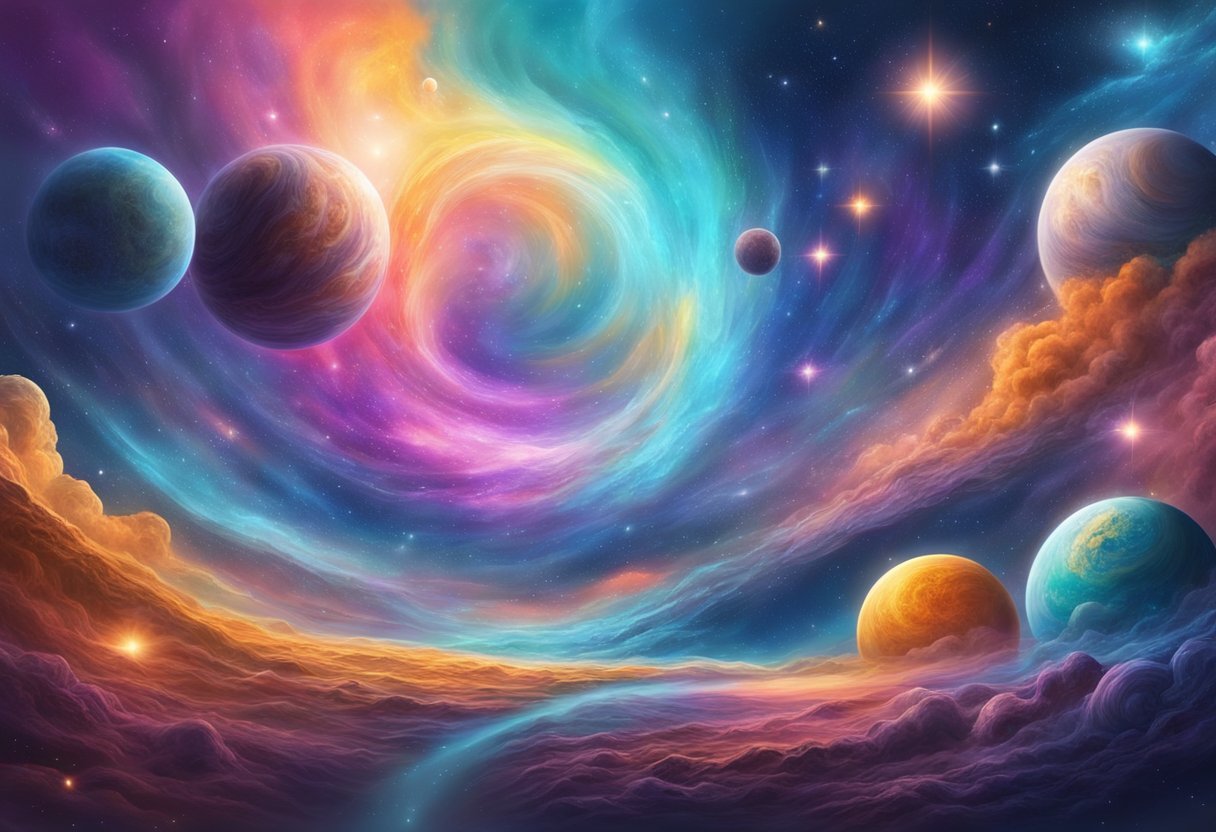The concept of an omniverse and a hyperverse has been a topic of interest among physicists and science fiction enthusiasts for some time. While these terms are often used interchangeably, they have distinct differences that set them apart. In this blog post, we will explore the Omniverse vs Hyperverse and elaborate on the differences and similarities between these two worlds
The omniverse refers to the collection of every single universe, multiverse, megaverse, dimension (alternate or pocket), and realm. This includes all fictional universes, as well as real-world theories and concepts. In contrast, the hyperverse is a concept used in fictional works to describe a higher level of reality beyond the multiverse. It is a realm of existence that transcends the laws of physics and is home to entities of immense power.
While the omniverse and hyperverse are often discussed in science fiction, they also have real-world implications. The study of these concepts can help scientists better understand the nature of reality and the laws that govern it. By exploring these ideas, researchers can gain new insights into the universe we live in and the possibilities that lie beyond it.
Defining the Concepts
The Universe and Multiverse
The universe is defined as all of space and time and its contents. It is the largest known structure and contains everything that exists, including galaxies, stars, planets, and living organisms. On the other hand, the multiverse is a hypothetical collection of multiple observable universes.
It is a concept that suggests that there are other universes that are similar to our own, but with different physical constants and laws of nature.
From Multiverse to Omniverse
The omniverse is a collection of every single universe, multiverse, metaverse, and more. It is a concept that encompasses all of reality, including every possible universe that could exist. The omniverse is a natural extension of the multiverse concept, and it suggests that there are other structures beyond the multiverse that we have yet to discover.
Hyperverse: A Theoretical Extension
The hyperverse is a theoretical extension of the omniverse concept. It is a hypothetical collection of every possible universe, multiverse, metaverse, and more that could exist.
The hyperverse concept suggests that there are structures beyond the omniverse that we have yet to discover, and it is a way to explore the limits of what could exist.
Universe is the largest known structure that contains everything that exists, while the multiverse is a hypothetical collection of multiple observable universes. The omniverse is a collection of every single universe, multiverse, metaverse, and more, while the hyperverse is a theoretical extension of the omniverse concept.
The omniverse and hyperverse concepts suggest that there are other structures beyond the multiverse that we have yet to discover, and they are a way to explore the limits of what could exist.
Omniverse vs Hyperverse: Differences and Similarities

When it comes to the differences and similarities between the omniverse and hyperverse, there are several key factors to consider. Here are three differences and three similarities between the two concepts:
Differences
- Size: The omniverse is a collection of every single universe, multiverse, and metaverse, while the hyperverse is a hypothetical space that exists beyond the confines of individual universes. In other words, the omniverse is all-encompassing, while the hyperverse is more limited in scope.
- Structure: The omniverse is made up of various interconnected universes, while the hyperverse is a single, unified space that exists beyond the boundaries of individual universes. This means that the omniverse has a more complex and diverse structure than the hyperverse.
- Accessibility: The omniverse is accessible to all beings within it, while the hyperverse is only accessible to those who possess the necessary knowledge and technology to enter it. This means that the omniverse is more open and inclusive than the hyperverse.
Similarities
- Multidimensionality: Both the omniverse and hyperverse exist beyond the confines of individual universes, and are therefore multidimensional in nature. This means that they both contain spaces and realities that are beyond our current understanding.
- Infinite Possibilities: Both the omniverse and hyperverse contain an infinite number of possibilities and potential realities. This means that there are countless different outcomes and scenarios that could play out within these spaces.
- Advanced Technology: Both the omniverse and hyperverse require advanced technology and knowledge to explore and understand. This means that they are both areas of study that require a high level of expertise and understanding to fully comprehend.
While the omniverse and hyperverse share some similarities, they are ultimately quite different in terms of size, structure, and accessibility. Both concepts are fascinating areas of study that offer infinite possibilities for exploration and discovery.
Technological Interpretations
Virtual Reality and Augmented Reality
The concept of omniverse and hyperverse has become increasingly popular in the virtual reality and augmented reality space. Virtual reality is a simulated experience that can be similar or completely different from the real world, while augmented reality is a technology that overlays digital information onto the physical world. The development of omniverse and hyperverse has allowed for the creation of more immersive and interactive virtual and augmented reality experiences.
Metaverse and Gaming Platforms
Metaverse and gaming platforms have been at the forefront of the development of omniverse and hyperverse. Metaverse is a collective virtual shared space, created by the convergence of virtually enhanced physical reality and physically persistent virtual space, including the sum of all virtual worlds, augmented reality, and the internet. Gaming platforms like Nvidia have been using omniverse and hyperverse to create more realistic and interactive gaming experiences for users.
Digital Twins and Industrial Applications
Omniverse and hyperverse have also been used in enterprise and industrial applications such as digital twins. Digital twins are virtual replicas of physical devices that can be used for simulation, monitoring, and control of industrial processes.
The development of omniverse and hyperverse has allowed for the creation of industrial digital twins that can accurately replicate physical spaces and processes. Universal Scene Description (USD) is a file format that is used to describe 3D scenes and has been used in the development of omniverse and hyperverse for industrial applications.
The development of omniverse and hyperverse has allowed for the creation of more immersive and interactive virtual and augmented reality experiences, gaming platforms, and industrial applications such as digital twins. The use of these technologies has allowed for the creation of more accurate and realistic simulations and has the potential to revolutionize the way we interact with digital reality.
Cultural and Social Impact of the omniverse and hyperverse
Science Fiction and Popular Culture
The concept of an omniverse has been a popular theme in science fiction for decades. Neal Stephenson’s novel Snow Crash, for instance, explores the idea of a metaverse, a virtual reality cyberspace that is accessible through the internet.
Other works of fiction, including Marvel Comics, DC Comics, and Dark Horse, have also explored the idea of alternate dimensions, many worlds, and parallel universes.
The emergence of an omniverse has led to a new era of immersive experiences, where users can interact with digital spaces and gaming platforms.
This has led to the creation of new ecosystems, where different entities, such as social media platforms, gaming platforms, and digital content creators, collaborate to create a more interactive and engaging experience for users.
Social Media and Online Communities
The emergence of an omniverse has also had significant impacts on social media and online communities. With the rise of web 3.0 and collaborative platforms such as Decentraland, users can now own and trade virtual real estate and other assets, including NFTs. This has created new opportunities for entrepreneurs and content creators to monetize their work and build their brand in the digital space.
However, the emergence of an omniverse has also raised concerns about ownership, security, and interoperability.
As more entities enter the digital space, it becomes increasingly important to ensure that users’ privacy and security are protected. Ensuring interoperability between different platforms and ecosystems is crucial to creating a seamless and engaging experience for users.
Economic and Legal Considerations
The emergence of an omniverse has also had significant economic and legal implications. As more users enter the digital space, new business models, such as GameFi and SocialFi, are emerging, creating new opportunities for entrepreneurs and investors. Companies such as Microsoft, Google, and Ericsson are investing heavily in the development of the omniverse, recognizing its potential to transform the way we interact with digital content and each other.
However, the emergence of an omniverse has also raised concerns about the extent of ownership and control over digital assets and ecosystems. As more entities enter the digital space, it becomes increasingly important to ensure that users’ rights and interests are protected.
The use of blockchain technology and other decentralized systems may be one way to ensure that users have greater control over their digital assets and ecosystems.
The emergence of an omniverse is transforming the way we interact with digital content and each other. While there are significant economic, legal, and social implications, the potential benefits of the omniverse are vast and far-reaching.
As the digital space continues to evolve, it will be crucial to ensure that users’ rights and interests are protected and that the omniverse continues to be a collaborative and engaging space for all.

Technological Advancements and Future Prospects
Artificial Intelligence and Machine Learning
The development of Artificial Intelligence (AI) and Machine Learning (ML) technologies has been a major driving force behind the growth of the Omniverse and Hyperverse. AI and ML have enabled the creation of intelligent agents that can interact with the virtual environment and perform complex tasks. These technologies have also helped in the creation of more realistic and immersive virtual worlds.
The Role of Big Tech Companies
Big Tech companies such as Facebook, Google, and Microsoft have been investing heavily in the development of the Omniverse and Hyperverse. These companies have been working on creating social media platforms that can be accessed through the virtual environment. They have also been working on developing alternate universes and parallel universes that can be accessed through the Omniverse and Hyperverse.
Emerging Technologies and Standards
Emerging technologies such as Augmented Reality (AR) and Virtual Reality (VR) have also played a significant role in the growth of the Omniverse and Hyperverse. These technologies have enabled the creation of more immersive and realistic virtual environments. Standards such as the Non-Fungible Token (NFT) have also helped in the creation of digital assets that can be bought, sold, and traded within the virtual environment.
The expansion of the Omniverse and Hyperverse is expected to continue in the future. As technology continues to advance, it is likely that we will see the creation of even more realistic and immersive virtual environments. However, it is important to consider the potential impact of these technologies on society.
Privacy, image rights, and laws governing the virtual environment will need to be carefully considered to ensure that the Omniverse and Hyperverse are used in a responsible and ethical manner.
Frequently Asked Questions
How does the Omniverse compare to the Multiverse in scale?
The Omniverse is considered to be a higher level of complexity than the Multiverse. While the Multiverse contains multiple independent worlds that share little to no data, the Omniverse implies a level of deep interoperability across worlds and platforms in which assets and characters flow from one to another. Therefore, the Omniverse is more expansive than the Multiverse.
Is the Hyperverse a larger concept than the Omniverse?
The Hyperverse is a concept that is often used in fiction and is not a scientifically recognized term. Therefore, it is difficult to compare its size to that of the Omniverse, which is a scientifically recognized term. However, some fictional contexts may rank dimensions differently, and in certain Multiverse models, not all Universes have the same structure or size.
What structure encompasses a collection of Megaverses?
A collection of Megaverses is known as a Metaverse. The Metaverse is a collective virtual shared space that is created by the convergence of multiple virtual worlds and augmented reality. It is considered a higher level of complexity than the Megaverse and is often used in science fiction and gaming.
Which is more expansive, the Omniverse or the Metaverse?
The Omniverse is a scientifically recognized term, while the Metaverse is a concept that is often used in science fiction and gaming. Therefore, it is difficult to compare their size. However, the Metaverse is a collective virtual shared space that is created by the convergence of multiple virtual worlds and augmented reality. In contrast, the Omniverse implies a level of deep interoperability across worlds and platforms in which assets and characters flow from one to another.
Can the Godverse be considered greater in magnitude than the Omniverse?
The Godverse is not a scientifically recognized term and is often used in fiction. Therefore, it is difficult to compare its size to that of the Omniverse, which is a scientifically recognized term. However, some fictional contexts may rank dimensions differently, and in certain Multiverse models, not all Universes have the same structure or size.
What is the next level of complexity beyond the Omniverse?
There is currently no scientifically recognized term that describes a higher level of complexity than the Omniverse. However, some fictional contexts may introduce concepts beyond the Omniverse, such as the Omniverse being a single atom in a larger universe.




